
All sources can be found below.
- 1886: Krimmer Mennonite Brethren establish the first African American Mennonite mission in the mining community at Elk Park, North Carolina. Missionaries involved included Heinrich V. Wiebe, Elizabeth Pauls Wiebe, Jacob M. Tschetter, Peter H. Siemens.
- 1897: First African Americans baptized as members of a Mennonite Church – Robert, Mary Elizabeth, and Cloyd Carter – at Lauver Mennonite Church, a congregation in the Juniata district of Lancaster Mennonite Conference.
- 1898: Welsh Mountain Mission established outside New Holland, PA. Early leaders included Amos H. Hershey, Samuel Musselman, Noah Mack, Levi Sauder, Lydia Stauffer Sauder, and Arthur T. Moyer. Elmer Boots was the first African American member to be baptized in 1917.
- 1920: Los Angeles Mennonite Church established in Inglewood, CA. Renamed Calvary Mennonite Church in 1942.
- 1920: Virginia Mennonite Conference debates allowing blacks in church. They are allowed with caution.
- 1920: Homer Church and Geneva Mercomes become the first African American students enrolled at Bethel College in North Newton, Kansas.
- 1927: James and Rowena Lark first contact with Mennonites at Rocky Ridge Mennonite Church in Quakertown, PA
- 1933: Lancaster Colored Mission established. Renamed South Christian Street Mennonite Church in 1939.
- 1933: Rondo Horton becomes the first African American ordained as a minister in the Mennonite Brethren church.
- 1935: Diamond Street Mennonite Church established in Philadelphia, PA. Alleanor, Edna, and Grace Jenkins received as first African American members in 1938.
- 1935: Broad Street Mennonite Mission established in Harrisonburg, VA
- 1938: Andrew’s Bridge Fellowship established near Christiana, PA, in southern Lancaster County.
- 1938: Seventh Street Mission established in Reading, PA. Renamed Buttonwood Mennonite Fellowship in 1971.
- 1940: 35th Street Mennonite Mission established in Los Angeles, CA
- 1940: Virginia Mennonite Conference issues policies segregating the rites of baptism, foot washing, the holy kiss, and communion.
- 1940s: James Lark establishes the first Mennonite “fresh air” camps for city youth.
- 1943: Juanita Lark becomes the first African American student to graduate from Goshen College
- 1943: Roberta Webb becomes the first African American person to join a Mennonite church in Harrisonburg, VA
- 1944: Bethel Mennonite Church established in Chicago, IL
- 1945: Dearborn Street Mission established in Chicago, IL
- 1945: Margaret “Peggy” Webb applies for admission to Eastern Mennonite College but is advised to enroll at Hesston College instead.
- 1946: Mennonite Central Committee established a voluntary service unit established in Gulfport, MS, to work with African American communities. The General Conference Mennonite Church assumed responsibility for the unit in 1953.
- 1946: James H. Lark ordained as first African American Mennonite minister at Bethel Mennonite Church, Chicago, IL.
- 1947: Mennonite Gospel Chapel established in Youngstown, OH. Later renamed Rockview Mennonite Church.
- 1947: Tillie Yoder establishes Camp Ebenezer in Holmes County, Ohio, with the help of her parents, neighboring churches, and the Mennonite Board of Missions. The camp was founded as a ministry for African American youth from Cleveland.
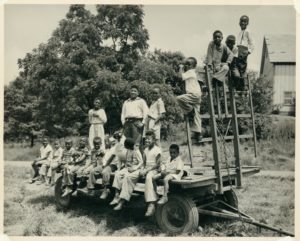
Camp Ebenezer in Holmes County, Ohio
- 1948: Willis Johnson becomes the first African American to enroll at Eastern Mennonite College as a part-time student. Ada Webb became the first full-time African American student in 1949.
- 1948: Gladstone Mennonite Church established in Cleveland, Ohio, and led by Vern and Helen Miller. Renamed Lee Heights Community Church in 1959. Gerald Hughes serves as pastor and music minister at Lee Heights from 1959 until his retirement in 1998.
- 1948: Southwestern Pennsylvania Conference statement on race
- 1949: Camp Rehoboth established in St. Anne, IL. Later renamed Rehoboth Mennonite Church.
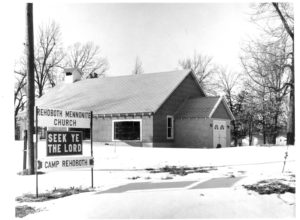
Rehoboth Mennonite Church
- 1949: Ninth Street Mennonite Church established in Saginaw, MI.
- 1949: Fox Street Mennonite Church established in the Bronx, NY.
- 1950: Le Roy Bechler ordained to ministry and serves as a church planter in Saginaw, MI, until 1960 and at Calvary Mennonite Church (Los Angeles, CA) from 1961 to 1979.
- 1951: Laurelville Study Conference on Christian Community Relations
- 1951: Lancaster Conference Bishop board statement on race (limited action)
- 1951: Woodlawn Mennonite Church established in Chicago, IL. J.N. Smucker served as the first pastor, followed by Delton Franz (1955-1958) and Vincent G. Harding (1958-1961).
- 1952: Newtown Gospel Chapel established in Sarasota, FL.
- 1952: Calvary Mennonite Church established by Nelson and Dorothy Burkholder in Newport News, VA as an integrated congregation, and mission of the Warwick River Mennonite Church.
- 1954: Harlem Mennonite Church established in Harlem, NY, and pastored by John Kraybill. Later renamed Seventh Avenue Mennonite Church.
- 1954: James H. Lark ordained as the first African American bishop
- 1954: Peggy Webb Howard became the first African American student to graduate from Eastern Mennonite College.
- 1954: Grace Chapel established in Saginaw, MI, by Melvin and Lois Leidig with the support of the Mennonite Board of Missions.
- 1955: Mennonite Church statement on race – The Way of Christian Love in Race Relations
- 1955: Bluffton College Statement on race
- 1957: Community Mennonite Church established in Markham, IL.
- 1958: Bethesda Mennonite Church founded in St. Louis, Missouri. Hubert Schwartzentruber serves as the first pastor.
- 1958: Vincent Harding joins the pastoral team at Woodlawn Mennonite Church in Chicago, IL, becoming the first black pastor in the General Conference Mennonite Church.
- 1959: General Conference Mennonites: A Christian Declaration on Race Relations
- 1959: At Community Mennonite Church (GC) in Markham, IL, a congregational policy to exclude “anyone who is not a Caucasian” is overturned, resulting in nearly one-third of the congregation leaving the congregation.
- 1959: Bethel Mennonite Mission established in Norristown, PA (later Bethel Mennonite Church) as a member congregation of Franconia Mennonite Conference. African American pastors over the years included Arthur Jackson (1964-66), Hubert Brown (1966-69), Arthur J. Griffin (1972-75), Herman W. Douglas (1973-85), and Ertell M. Whigham (1985-90).
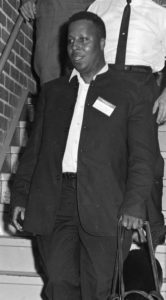
Arthur Jackson
- 1959: General Conference and “Old” Mennonite leaders come together at Woodlawn Mennonite Church in Chicago for a seminar on Christ, the Mennonite Church, and race.
- 1959: Elmer Neufeld (Executive Secretary of the MCC Peace Section) and Guy F. Hershberger attend a conference on nonviolent resistance led by the Southern Christian Leadership Conference (SCLC) in Atlanta. Their attendance marked an ongoing relationship between Mennonite leaders and the SCLC.
- 1960: Arthur Cash begins as minister at Fair Haven Mennonite Church in Fort Wayne, IN.
- 1960: Dr. Martin Luther King, Jr., speaks at Goshen College on “The Future of Integration.”
- 1960: Dr. Martin Luther King, Jr., speaks at Bethel College on “The Future of Integration.”
-
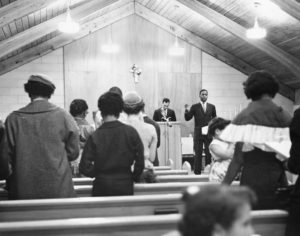
Lee Heights 1960
1960: John C. Branham joined Lee Heights Community Church and began his ministry in the broader community. He was ordained as a prison chaplain by the Ohio Mennonite Conference in 1971.
- 1960: Leslie Francisco II named deacon at Calvary Mennonite Church in Newport News, VA.
- 1960: Lancaster Conference Statement on Race Relations
- 1960: Eunice Bass, first person of color to integrate pre-nursing program at Eastern Mennonite College
- 1960: Students of Mennonite Biblical Seminary (Chicago) travel to Georgia, Alabama, and Mississippi to meet with and learn from southern students, pastors, activists, and leaders in the Civil Rights Movement. Education learning tours to the south were common during the late 1950s and early 1960s.
- 1961: Richard W. Pannell joins Seventh Street Mennonite Church in Harlem, NY.
- 1961: Billy Curry was credentialed as a deacon in VA Conference in.
- 1961: Vincent and Rosemarie (Freeney) Harding established “Mennonite House,” a Mennonite Central Committee voluntary service unit in Atlanta, GA.
- 1961: The Christian In Race Relations Statement/Paper
- 1963: Mennonite General Conference statement on Reconciliation
- 1963: Mennonite Brethren Statement on Race and Baptism
- 1963: IN-MI statement on race Relations
- 1963: “Old” Mennonite Church moderator John R. Mumaw sends a telegram to President John F. Kennedy expressing the church’s “strong support” for the establishment of racial equality, justice, and reconciliation.
- 1963: “Old” Mennonite Church leader Guy F. Hershberger sends a letter to every US congressman on behalf of the Committee on Economic and Social Relations and the MCC Peace Section, advocating for the “emancipation of our citizens of color.”
- 1964: MCC Statement from Words to Deeds in Race Relations
- 1964: EMC Faculty Statement on Race Relations
- 1964: MCC Peace Section statement on race discrimination and human rights
- 1964: Virginia Conference Statement on Race Relations
- 1965: Tony Brown becomes the first African American student at Central Christian High School in Kidron, Ohio.
- 1965: Vincent Harding formally resigns from his position with Mennonite Central Committee due to a strained relationship with church leadership and troubled personal life.
- 1966: Leslie Francisco II ordained as a minister at Calvary Mennonite Church in Newport News, VA
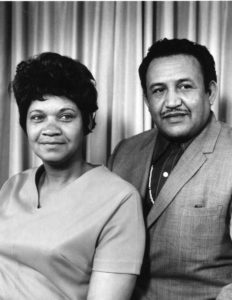
Naomi and Leslie Francisco
- 1966: Curtis Burrell begins as pastor at Woodlawn Mennonite Church in Chicago, IL
- 1967: Charles McDowell serves as the first African American minister at Rockview Mennonite Church in Youngstown, Ohio.
- 1967: Virginia Conference statement overturning segregation
- 1967: Vincent Harding delivers speeches at Mennonite World Conference Assembly in Amsterdam and addresses Mennonites’ acquiescence to white identity: “Sometimes, though, we clearly control the power, subtle power, like the power of Mennonite prestige, the power of middle-class respectability, the power of whiteness. Can we recommend the way of powerlessness while we dwell comfortably among the powerful?”
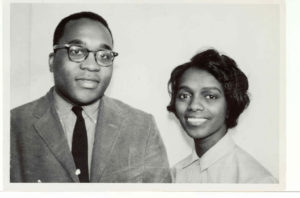
The Hardings: Used with permission, MCC U.S. Archives, Akron, PA
- 1968: Representatives of urban interracial churches form the Urban Racial Council. Lee Roy Berry, Gerald Hughes, Hubert Schwartzentruber, John Powell and John Ventura are elected as the first officers.
- 1968: Creation of the Afro-American Society at Goshen College. Renamed the Black Student Union in 1971.
- 1969: John Powell is appointed Executive Secretary for Minority Ministries Council, becoming the first person of color to serve as an administrator at the national level of the denomination.
- 1969: Mennonite Church General Conference Statement on Urban-Racial Concerns
- 1969: Lancaster Conference Statement on the Black Manifesto
- 1969: Lee Roy Berry, professor of political science, becomes the first African American faculty member at Goshen College.
- 1970: Calvary Mennonite Christian Day School in Inglewood, California, begins. It is the first Black Mennonite elementary school.
- 1971: Minority Ministries Council Statement to the Mennonite Church
- 1971: Black Caucus of the (old) Mennonite Church formed
- 1971: Lancaster Conference Statement on Racism
- 1972: First Cross-Cultural Youth Convention
- 1973: Angie Williams becomes first African American woman on the executive committee of the Women’s Missionary and Service Commission, serving as vice president.
- 1974: Hubert Brown is appointed Executive Secretary of Student & Young Adult Services for Mennonite Board of Missions.
- 1974: John Powell resigns from his position with Mennonite Board of Missions
- 1975: Egla Birmingham became the first African American woman to serve as a staff person for Mennonite Board of Missions
- 1975: Rose Covington first African American appointed to Mennonite Publication Board, serving ten years.
- 1976: Liberty and Justice Workshop statement
- 1976: Dwight McFadden appointed General Secretary for Black Concerns
- 1976: Raymond Jackson becomes first African American minister at Bristol Mennonite Church in Bristol, PA, and serves until 1987
-
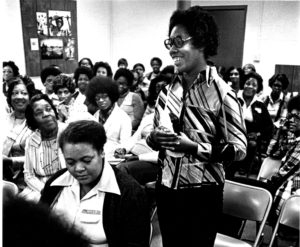
Frances Jackson
1977: Frances Jackson organizes the first African American Mennonite women’s retreat.
- 1977: Cross Cultural Relations Center established at Goshen College “to provide academic counseling, promote campus sensitivity to minority students, and provide programs for minority students.” Sylvia Dyson serves as first full-time director.
- 1978: Mennonite Board of Missions appoints Ed Taylor as Associate Secretary of Home Missions.
- 1979: Goshen College launches the James Lark Leadership Education Program, “designed to develop African-American Mennonite lay and professional leadership.”
- 1980: Ivorie Lowe, member at Community Mennonite Church in Markham, IL, appointed as a member of the General Conference Commission on Home Ministries. Among other churchwide leadership roles, she was named a member of the MC USA Leadership Discernment Committee in 2001.
- 1980: Wilma Ann Bailey is the first African American woman licensed for ministry in the Indiana-Michigan Conference at Grace Chapel, Saginaw, Michigan.
- 1980: Abraham Davis becomes the first director of the Cross-Cultural Center at Eastern Mennonite College.
- 1980: Hubert L. Brown begins as pastor of Calvary Mennonite Church in Inglewood, CA.
- 1982: African American Mennonite Association established as the successor to the Black Caucus of the (old) Mennonite Church.
-
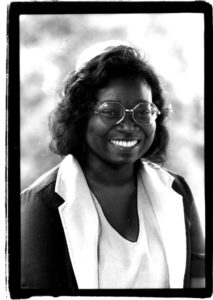
Joy Lovett
1982: Joy Lovett becomes Associate Secretary for Black Concerns in the (old) Mennonite Church
- 1985: Roy W. Williams begins as pastor at College Hill Mennonite Church in Tampa, Florida.
- 1986: Le Roy Bechler authors the first history of African Americans in the Mennonite Church in North America
- 1986: Virginia Mennonite Conference commissioned Leslie Francisco III as second African American Mennonite bishop in North America.
- 1986: Eric Payne revives the Black Student Union at Eastern Mennonite College, initially attempted in the 1960s.
- 1987: James Isaacs becomes the second African American moderator of the Southwest Mennonite Conference, following Hubert Brown.
- 1989: Les Tolbert begins as pastor at Community Mennonite Church in Markham, IL, and serves until 1992.
- 1989: At a joint assembly in Normal, IL, the General Conference Mennonite Church and the Mennonite Church pass the resolution, “A Church of Many Peoples Confronts Racism.”
- Bethel Mennonite Church joined with First Mennonite Church and Iglesia Menonita Fuente de Salvación to form Nueva Vida Norristown New Life Mennonite Church in Norristown, PA. Ertell M. Whigham was one of three founding pastors, together with Paul Leichty and Henry Ortiz.
- 1992: Brenda Isaacs becomes the first African American woman ordained in the Mennonite Church, serving as pastor at Calvary Christian Fellowship in Inglewood, CA. She also serves as principal of Calvary Christian School and chair of the Southwest Mennonite Conference Ministerial Committee.
- 1992: Goshen College alum Zenebe Abebe (’75) was hired as Vice President for Multicultural Education. In 1993, Abebe helped launch GC’s annual Martin Luther King Jr. Study Day.
- 1992: Rose Covington becomes pastor of Rehoboth Mennonite Church in Pembroke, IL.
- 1993: Mennonite Central Committee begins racism awareness program.
- 1993: James Logan begins as Director of Community Ministries at Mennonite Central Committee (U.S.) and serves until 1997. He later served on the MCC binational board from 2010-2012.
- 1993: Stanley Green called to be president of Mennonite Board of Missions. In 2001 he is called to continue as executive director of Mennonite Mission Network, the mission agency of the emerging Mennonite Church USA, where he served until his retirement in 2020.
- 1994: John Powell returns to employment at MBM as a consultant for Evangelism and Church Development.
- 1994: Brent Foster begins as pastor at Community Mennonite Church in Markham, IL, and serves until 1997.
- 1995: Regina Shands Stoltzfus and Tobin Miller Shearer co-found the Damascus Road Antiracism Process with the support of Mennonite Central Committee.
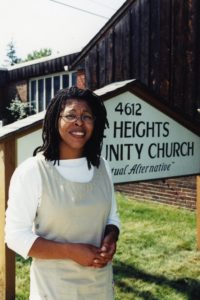
Regina Shands Stoltzfus
- 1995: Regina Shands Stoltzfus begins service as associate pastor at Lee Heights Community Church in Cleveland, Ohio.
- 1997: Dwight McFadden, Jr., begins service as the first African American moderator in the (old) Mennonite Church
-
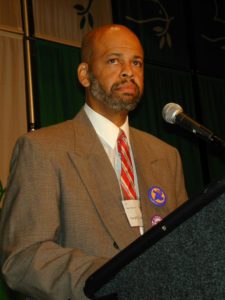
Dwight McFadden, Jr
1999: Jon Moore began as pastor at New Beginnings Community Church in Bristol, PA.
- 1999: Leonard Dow began as pastor at Oxford Circle Mennonite.
- 2000: Horace McMillon begins as pastor at Community Mennonite Church in Markham, IL. In 2005 he moves to Jackson, MS, with his family to serve as pastor of Open Door Mennonite Church.
- 2001: B. Elaine Bryant, pastor at Englewood Mennonite Church in Chicago, IL, elected as a member of the Mennonite Church USA Executive Board.
- 2002: Regina Shands Stoltzfus begins as campus pastor at Goshen College and continues in this role until 2005.
- 2003: Roy W. Williams named moderator-elect of Mennonite Church USA at Assembly in Atlanta, Georgia.
- 2007: Cyneatha Millsaps begins as pastor at Community Mennonite Church in Markham, IL.
- 2008: Benjamin and Hyacinth Stevens begin as co-pastors at King of Glory Tabernacle in the Bronx, NY.
- 2009: Glen Guyton joins Mennonite Church USA staff as director of intercultural relations
- 2011: Addie Banks becomes the first African American woman ordained by the Lancaster Mennonite Conference.
- 2011: Ertell M. Whigham becomes the first African American to lead an MCUSA conference in a staff position, serving as Executive Minister for Franconia Mennonite Conference.
- 2012: Mennonite Church USA begins Hope for the Future gatherings, bringing together leaders of color from across the church, sometimes with white allies, to explore the ways that power, privilege and racism function in the denomination.
- 2014: Mennonite Church USA’s “Purposeful Plan” includes a commitment to undoing racism, one of seven priorities developed to guide the work of the Executive Board staff.
- 2014: Malinda Elizabeth Berry begins as Assistant Professor of Theology and Ethics at Anabaptist Mennonite Biblical Seminary, becoming the first Black faculty member at the seminary
- 2016: Michelle Armster begins as Executive Director of Mennonite Central Committee Central States.
- 2018: Cyneatha Millsaps begins as Executive Director of Mennonite Women USA
- 2018: Glen Guyton installed as the first African American executive director of Mennonite Church USA.
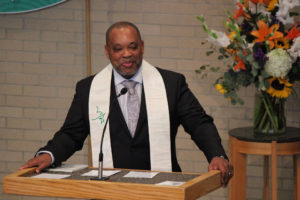
- 2019: Eastern Mennonite University opens “The Royal Treatment,” a lounge and barbershop managed by the Black Student Union.
- 2019: Shannon Dycus began as dean of students at EMU.
- 2020: Charlene Smalls was licensed as a pastor at Ripple Allentown.
- 2021: Michelle Armster honored with MC USA’s first #BringThePeace award
- 2021: Regina Shands Stoltzfus receives the Everence National Journey award. With coauthor Tobin Miller Shearer, she also publishes Been in the Struggle: Pursuing and Antiracist Spirituality with Herald Press.
- 2022: Hyacinth Stevens named the Executive Director for Mennonite Central Committee East Coast.
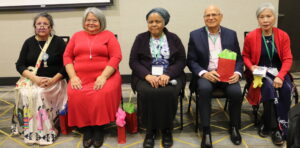
Hope for the Future 2023 honorees (from left): Susan Hart, Iris de Leon-Hartshorn, Dr. Wilma Bailey, Marco Guete and Kim Vu Friesen. Missing: Michelle Armster, John Powell. Photo by Lynn Hur.
- 2023: Michelle Armster, John Powell and Wilma Bailey, were among six BIPOC leaders honored for their lifetime achievements and service to the church at MC USA’s Hope for the Future conference, Feb. 3-5, in Atlanta, Georgia.
- 2024: Bishop L.W. Francisco III, oversight pastor of Calvary Community Church (C3) and president of MC USA’s African American Mennonite Association, was among seven BIPOC leaders honored for their lifetime achievements and service to the church at MC USA’s Hope for the Future conference, Feb. 9-11 in Dallas, Texas.
Sources:
- Le Roy Bechler, The Black Mennonite Church in North America, 1886-1986. Scottdale, PA: Herald Press, 1986.
- Donald B. Kraybill, Eastern Mennonite University: A Century of Countercultural Education, Penn State Press, Sep 12, 2017
- Global Anabaptist Mennonite Encyclopedia Online
- African American History at EMU: A Timeline, accessed 1/27/2020
- “10 Moments that Shaped the African American History of Goshen College,” accessed 1/27/2020
- John E. Sharp, “A Historical Timeline of Minority and Urban Ministry in the United States, 1910-1997
- Tobin Miller Shearer, Daily Demonstrators: The Civil Rights Movement in Mennonite Homes and Sanctuaries, Baltimore, MD: Johns Hopkins University Press, 2010.
- Anita Hooley Yoder, Circles of Sisterhood: A History of Mission, Service, and Fellowship in Mennonite Women’s Organizations. Harrisonburg, VA: Herald Press, 2017.
- anabaptisthistorians.org accessed 1/28/2020


